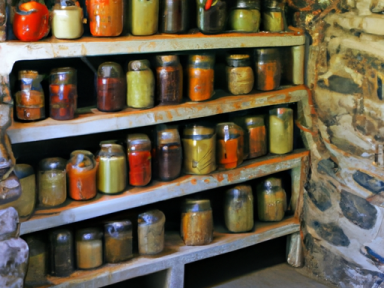Step-by-step Guide on Building a Root Cellar for Long-term Food Storage
Are you concerned about the possibility of a crisis or disaster that could disrupt our society and leave us without access to food and other essential resources? If so, you are not alone. As a homesteader and advocate for self-reliance, I believe it’s crucial to be prepared for such scenarios.
One of the key elements of preparing for an uncertain future is having a reliable and efficient method for long-term food storage. And what better way to achieve this than by building your own root cellar? A root cellar is a simple and effective way to store fruits, vegetables, and other perishable items for extended periods without the need for electricity or refrigeration.
With that in mind, let’s dive into the step-by-step guide on how to build your own root cellar.
Step 1: Location and Design
The first step is to determine the location and design of your root cellar. Ideally, you want to choose a spot that is cool, dark, and well-drained. The location can be in your basement, underground, or even in a separate structure.
The design of your root cellar can vary depending on your available space and personal preferences. Some common options include a dugout cellar, a build-in cellar, or even a modified shipping container. Choose a design that suits your needs and resources.
Step 2: Excavation
Once you have finalized the location and design, it’s time to start the excavation process. Dig a hole in the ground according to the dimensions of your chosen design. Make sure to account for the depth needed to provide a consistent temperature and humidity throughout the year.
Remember to reinforce the walls and ceiling of your cellar to ensure stability and prevent collapses. Use strong, durable materials such as concrete or bricks for added strength.
Step 3: Insulation and Ventilation
Proper insulation is essential to maintain a stable temperature and humidity inside your root cellar. Insulate the walls and ceiling with materials like straw, foam insulation, or even recycled tires. This will help to keep the cellar cool in the summer and prevent freezing in the winter.
Additionally, ensure sufficient ventilation to allow for air circulation and control moisture levels. Install vents or small windows with screens to keep pests out while allowing fresh air to flow into the cellar. Good ventilation helps prevent the buildup of mold and mildew.
Step 4: Flooring and Shelving
Next, it’s time to install flooring and shelving in your root cellar. Use materials such as concrete, gravel, or even wooden planks for the flooring. Choose sturdy and moisture-resistant materials for the shelving, ensuring they can support the weight of your stored food.
Organize your shelves in a way that allows for easy access to your stored items. Consider installing racks or hooks on the walls for hanging produce such as onions and garlic.
Step 5: Lighting and Security
While darkness is ideal for root cellars to prolong the shelf life of your food, it’s also important to have some form of lighting for your convenience. Use battery-powered LED lights or solar-powered options to ensure you can navigate the cellar efficiently.
Additionally, consider implementing security measures. Install sturdy doors with reliable locks to protect your food from potential thieves or pests.
Step 6: Stocking Your Root Cellar
Finally, it’s time to start stocking your root cellar with fresh produce and other food items. Remember to choose fruits and vegetables that store well in a cool and dark environment. Some excellent options include potatoes, carrots, apples, onions, and squash.
Keep an inventory of your stored food and rotate it regularly to ensure nothing goes to waste. By preserving your harvest properly, you can enjoy homegrown food all year round, even during challenging times.
Conclusion
Building a root cellar is a substantial step towards self-reliance and preparedness. By following this step-by-step guide, you can create a reliable and efficient storage space for your long-term food supply.
Remember, it’s not a matter of if but when a crisis or disaster may strike. Taking action to become more self-reliant and prepared will not only provide protection for yourself and your loved ones but also give you peace of mind in uncertain times.
Begin building your root cellar today, and take control of your food security for a more resilient future.




GIPHY App Key not set. Please check settings